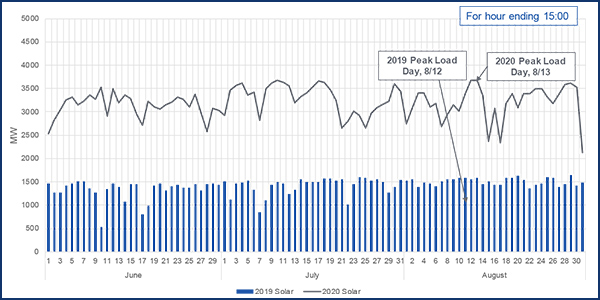ERCOT has learned to live with a wind trough during the early afternoon hours, when coastal breezes drop and West Texas turbines aren’t spinning.
The same phenomenon is taking place with solar energy as it becomes a more reliable resource for the grid.
Dan Woodfin, ERCOT’s senior director of system operations, said last week that the summer sun sets about 7:30 or 8 p.m. in the west, where most of Texas’ wind farms are. The loss of solar production took place shortly after thermal generation shut down after helping meet peak demand, resulting in tighter operating conditions and lower operating reserves.
“There’s kind of an interaction there that hasn’t typically been there,” Woodfin said during a Gulf Coast Power Association webinar Wednesday. “It didn’t cause us a problem, but it did cause us to be a little tighter on some of those days during the early afternoon. As solar continues to grow on the system, it’s something we’re going to have to watch over.”
ERCOT had about 2.1 GW of additional installed solar capacity at the start of last summer than it did in 2019. Solar farms generally provided between 2.2 and 3.7 GW of energy from 2 to 3 p.m. this summer after producing a fairly steady 1.5 GW during the same period last summer.
“There was a little more variability around the solar output this year,” Woodfin said. “That’s just a matter of having more installed capacity.”
To address the solar trough, staff proposed a system change request (SCR811) that the Board of Directors approved in October. The SCR adds the short-term solar forecast to the resource-limit calculator’s formula for calculating the generation-to-be-dispatched value.
“Every five minutes it will start to look at the drop-off in solar and dispatch the rest of the generation,” Woodfin said.
He said the change is designed to avoid adding more system requirements to cover the balancing during each five-minute interval as solar production drops off.
“It will also provide an incentive for [thermal] generation to incrementally stay online as solar drops off by having the prices reflect that,” Woodfin said.
ERCOT began the year with about 2.3 GW of installed solar capacity but expects to end the year with about 5.2 GW. The grid operator expects to install as much as 10 GW of solar capacity by the end of 2022, with more planned for the future. The interconnection queue contains a staggering 81.3 GW of solar projects under some form of study.






